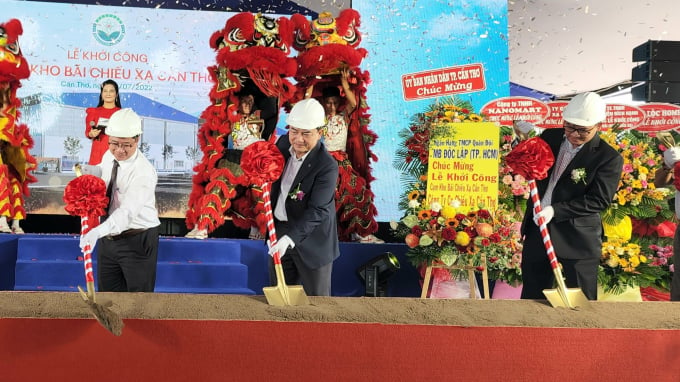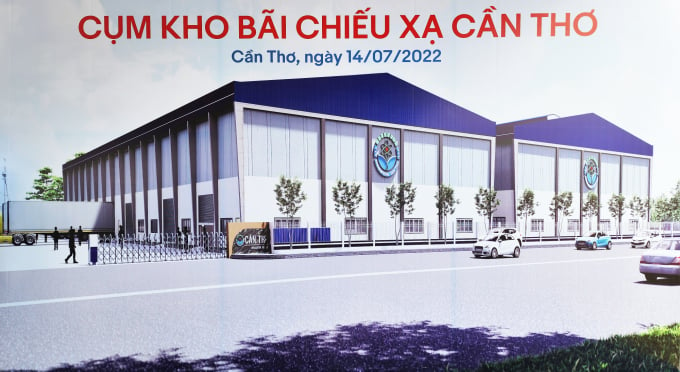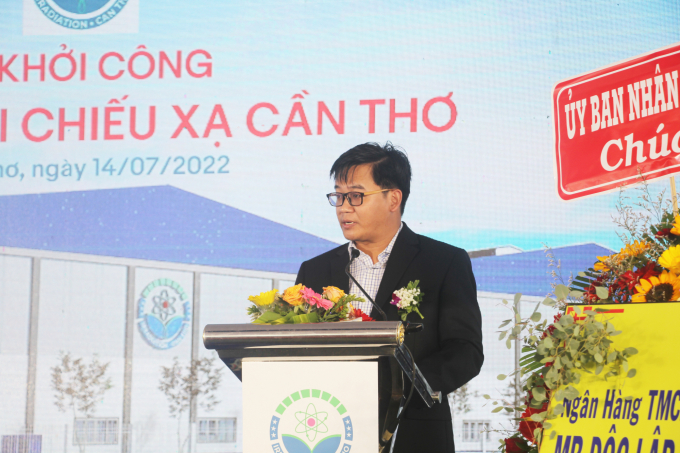November 6, 2025 | 05:48 GMT +7
November 6, 2025 | 05:48 GMT +7
Hotline: 0913.378.918
November 6, 2025 | 05:48 GMT +7
Hotline: 0913.378.918
Every year, the Mekong Delta region has a demand to transport about 18 million tons of export goods. However, this region does not have a large-capacity irradiation center to meet such a demand for large and fastidious markets.
This leads to the fact that 70% of the region's goods have to be transported to major ports in Ho Chi Minh City and Cai Mep Port on Ba Ria - Vung Tau, making transportation costs rise to 10-40% higher (depending on the routes), affecting the competitiveness of Vietnamese goods in the market.

Groundbreaking ceremony for an irradiation warehouse complex in Can Tho city. Photo: Kim Anh.
Many seminars were held to find solutions on removing bottlenecks for the logistics industry in the Mekong Delta in which agricultural experts pointed out that cold storage systems, sea transport connection and the development of large capacity irradiation centers in the region were urgently essential issues.Can Tho Irradiation Joint Stock Company (ICT) held a groundbreaking ceremony at Can Tho port on July 14 for a warehouse complex and a multi-purpose industrial irradiation line with an expected capacity of up to 50,000 tons/year. When put into operation, the cluster will play an important role in solving logistics problems for the whole Mekong Delta.
Specifically, in phase 1, ICT will build a multi-purpose industrial irradiation line VINAGA1 using Cobalt-60 source, a current popular technology in the world. This technology is designed and manufactured by the Center for Research and Development of Radiation Technology (VINAGAMMA) of the Vietnam Atomic Energy Institute.The line is expected to go into operation in early 2023, on an area of nearly 2ha in Phu Thang area, Tan Phu ward, Cai Rang district, Can Tho City.

The model of irradiation warehouse complex at Can Tho port. Photo: Kim Anh.
Along with that, a warehouse complex, including 1 normal warehouse, 3 cold storages with storage temperatures of 0 degrees Celsius and 15 degrees Celsius, was also built to meet the businesses' diverse demands.
According to Mr. Tran Chi Thanh, Director of the Institute of Atomic Energy (IAE) under the Ministry of Science and Technology, currently irradiation technology is developing strongly with many private units having used this technology for the irradiation quarantine purpose in export.
In the South, a number of units have also engaged in the field but with a smaller scale and not a large quantity. It is obvious that an irradiation unit in Can Tho city is very necessary for the export of agricultural and aquatic products of the Mekong Delta.
Mr. Thanh affirmed the irradiation center in Can Tho is the first one built at a Vietnamese port. “Irradiation centres built previously are often located outside the port so the transportation and custom irradiation are not close to each other causing an increase in the cost of exported goods. The construction of an irradiation center and a warehouse cluster at Can Tho port will contribute to closing the export process quickly, saving costs and being convenient for businesses," said Thanh.

Mr. Nguyen Trong Tin, Chairman of the Board of Directors of Can Tho Irradiation Joint Stock Company, said that the cluster of irradiation warehouses at Can Tho port will contribute to completing the logistics center of the Mekong Delta. Photo: Kim Anh.
Mr. Nguyen Trong Tin, Chairman of the Board of Directors of Can Tho Irradiation Joint Stock Company, expressed that the company's long-term goal is to promote the application of atomic energy, to bring nuclear science and technology to life, especially to promote sustainable agricultural development.The construction of a warehouse complex and an irradiation line at Can Tho port will contribute to completing a regional logistics center with full functions of transport - distribution - storage - irradiation.
At the same time, it will help remove the biggest bottleneck for the economic development of the Mekong Delta in terms of the logistics linkage from production to consumption, strongly promoting the export of goods through Can Tho port.
According to the IAE, irradiation technology is using radioactive rays to kill insects, molds and bacteria in food. It helps agricultural and aquatic products achieve higher quality, long preservation time, serving for export to countries with different requirements.This technology has been studied, researched and transferred by the IAE Since the 1980s, the Institute has deployed the first irradiation line in Hanoi. In 1999, it opened another in HCM City and one at a unit under the Institute.
Translated by Linh Nguyen

(VAN) More than 400 experts from domestic and international organizations attended the ACT Con 2025 conference, which aimed to connect technology developers with frontline conservation teams.

(VAN) Food irradiation technology is an innovative solution that extends shelf life and acts as a ‘golden visa’ enabling Vietnamese agricultural products to access the world’s most demanding markets.

(VAN) At Dinh My commune (An Giang province), Loc Troi Group recently organized Mini Expo 2025 under the theme ‘From technology to practice – Comprehensive cultivation solutions for crops.’
/2025/11/04/2510-4-162016_246.jpg)
(VAN) The launch of the 'Carbon for Good' project in Lai Chau opens up a new direction in forest management and protection, laying the foundation for developing carbon credits.

(VAN) Hai Phong is implementing a comprehensive greenhouse gas inventory program, promoting sustainable and eco-friendly development.
/2025/11/01/5020-0-nongnghiep-235014.jpg)
(VAN) According to the FAO Representative in Vietnam, innovation for a sustainable food future must stem from fresh ideas of young people who dare to think differently.

(VAN) The adoption of LED lighting technology in fishing operations is expected to help local fishermen cut fuel costs, boost catch efficiency, and progressively modernize their fishing fleets.